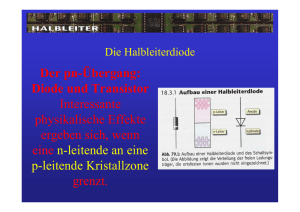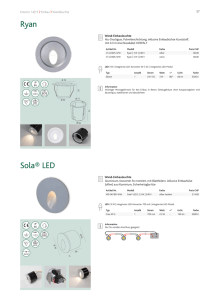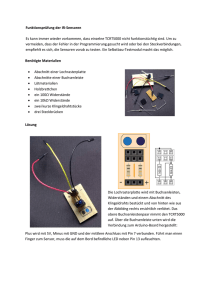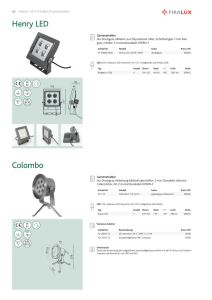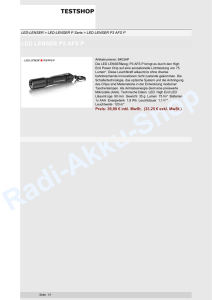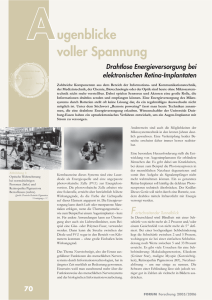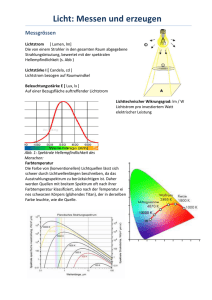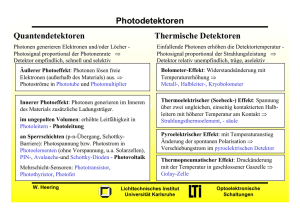LED = pn Übergang in direktem Halbleiter
Werbung
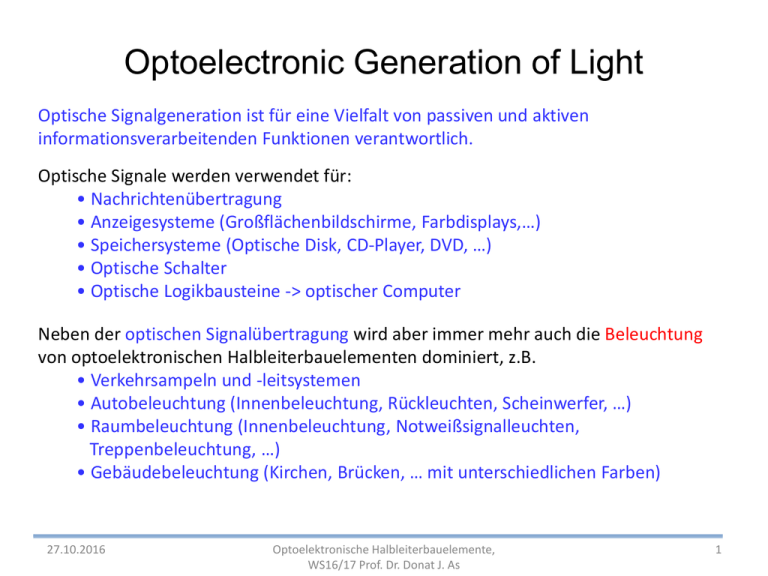
Optoelectronic Generation of Light Optische Signalgeneration ist für eine Vielfalt von passiven und aktiven informationsverarbeitenden Funktionen verantwortlich. Optische Signale werden verwendet für: • Nachrichtenübertragung • Anzeigesysteme (Großflächenbildschirme, Farbdisplays,…) • Speichersysteme (Optische Disk, CD-Player, DVD, …) • Optische Schalter • Optische Logikbausteine -> optischer Computer Neben der optischen Signalübertragung wird aber immer mehr auch die Beleuchtung von optoelektronischen Halbleiterbauelementen dominiert, z.B. • Verkehrsampeln und -leitsystemen • Autobeleuchtung (Innenbeleuchtung, Rückleuchten, Scheinwerfer, …) • Raumbeleuchtung (Innenbeleuchtung, Notweißsignalleuchten, Treppenbeleuchtung, …) • Gebäudebeleuchtung (Kirchen, Brücken, … mit unterschiedlichen Farben) 27.10.2016 Optoelektronische Halbleiterbauelemente, WS16/17 Prof. Dr. Donat J. As 1 Solid State Lighting (SSL) 27.10.2016 Optoelektronische Halbleiterbauelemente, WS16/17 Prof. Dr. Donat J. As 2 Light Emitting Diode (LED) Die Licht emittierende Diode (LED, Leuchtdiode) ist eins der einfachsten optoelektronischen Bauelemente, welches besonders wichtige Anwendung in der Displaytechnologie (Hintergrundbeleuchtung von Handydisplays, Monitore) als auch als optische Signalquelle für optische Nachrichtenübermittlung bekommen hat. Auch in der Beleuchtungstechnik (Autoscheinwerfer, Raumbeleuchtung, Taschenlampen,..) werden LEDs immer wichtiger. Im Vergleich zu Laserdioden (LD) ist eine LED relativ einfach und benötigt keinen optischen Resonator zum Betrieb: Nachteile sind jedoch: • niedrige optische Ausgangsleistung (stimmt nur mehr teilweise) • breites und inkohärentes Emissionsspektrum • langsamere Modulierbarkeit (< 100 MHz) Die Basis für eine LED ist ein p-n-Übergang, der in Vorwärtsrichtung betrieben wird! 27.10.2016 Optoelektronische Halbleiterbauelemente, WS16/17 Prof. Dr. Donat J. As 3 Power of LED 27.10.2016 Optoelektronische Halbleiterbauelemente, WS16/17 Prof. Dr. Donat J. As 4 Development of the power of LED • Der Fortschritt in der Effizienz von LEDs ist sehr groß • Für weiße LEDs hat Phillips 2013 200 lm/Watt weißes Licht erreicht • 15 lm/W für Glühlampe, 50-100 lm/Watt für eine Leuchtstoffröhre • Auch für rote LEDs sind 200 lm/Watt erzielt worden (Osram 2011) • Mehr als 60 % der elektrischen Leistung werden in Licht umgesetzt. 27.10.2016 Optoelektronische Halbleiterbauelemente, WS16/17 Prof. Dr. Donat J. As 5 LED: Basics Die LED ist die Grundvoraussetzung für eine Laserdiode (LD), deren Anwendung für Modulationsgeschwindigkeiten oberhalb von 5 GHz benötigt werden oder wo spektral reine optische Emission (Dl < 1nm) benötigt werden. Spektrale Breite einer LED: ~kBT dies entspricht bei Raumtemperatur (~26 meV) einem Wellenlängenbreite von ca. 30-40 nm. für menschliches Auge trotzdem monochromatisch Grundlage der LED ist ein vorwärts gespannter p-n-Übergang, in dem Elektronen (Löcher) in das p-(n-) Gebiet injiziert werden. Die injizierten Minoritätsladungsträger rekombinieren mit den Majoritätsladungsträgern in der Verarmungszone oder dem neutralen Bereich. In direkten Halbleitern (wie z.B. GaAs) führt diese Rekombination zur Lichtemission da dort strahlende Rekombination überwiegt. In indirekten Halbleitern (wie z.B. Si) erfolgt die Rekomination überwiegend zur Erzeugung von Phononen (Gitterschwingungen) und damit nichtstrahlend. LED = p-n Übergang in direktem Halbleiter 27.10.2016 Optoelektronische Halbleiterbauelemente, WS16/17 Prof. Dr. Donat J. As 6 p-n-junction: electronic properties photon V 27.10.2016 Optoelektronische Halbleiterbauelemente, WS16/17 Prof. Dr. Donat J. As 7 Direct - indirect Semiconductor Phononen Important considerations for the selection of a semiconductur for LED or Laser diodes: • Emission energy (wavelength for the used application) • Availability of suitable substrate (Growth of epitaxial layers) Connection: Energy – wavelength: 27.10.2016 1239,85 E (eV ) l nm Optoelektronische Halbleiterbauelemente, WS16/17 Prof. Dr. Donat J. As 8 Emission wavelength Generation of light by recombination of e-h-pairs above the band gap! => Band gap Eg determines the emission energy! 27.10.2016 Optoelektronische Halbleiterbauelemente, WS16/17 Prof. Dr. Donat J. As 9 Availability of substrates • Nearly all optoelectronic light sources depend on epitaxial growth methodes • Thick active epitaxial layers (~ some µm) are deposited on thick substrates (~200-700 µm). • For high quality devices the epilayer have to be as defect free as possible (Defects = non-radiative rekombination centers) • Availability of high quality substrates is very important for the epitaxy, since with lattice mismatched substrates the formation of dislocations and other defects is possible. The most important available substrats for LED-technology are: a) Si b) GaAs c) InP d) Saphir e) LiNbO2 } genügend rein, kommerziell erhältlich, groß genug ( 2-3 Zoll) However, only a few semiconductors and their alloys are lattice matched to the substrates. 27.10.2016 Optoelektronische Halbleiterbauelemente, WS16/17 Prof. Dr. Donat J. As 10 Lattice constant of compound semiconductors The lattice constant of a co,mpound is in good approximation the wheighted mean value of the different components, e.g. the lattice constants of the alloy compound AxB1-x is. (z.B. A = GaAs, B= InAs) a x aA 1 x aB Vegards law where aA and aB are the lattice constants of material A and B. This lineare Interpolation is called Vegards law. Important Semiconductors for optoelectronic applications are: a) GaxAl1-xAs b) In0.53Ga0.47As c) In0.52Al0.48As d) InGaAsP 27.10.2016 lattice matched to GaAs lattice matched to InP lattice matched to InP lattice matched to GaAs (visible spectral range) Optoelektronische Halbleiterbauelemente, WS16/17 Prof. Dr. Donat J. As 11 Lattice constants of binary compound semiconductors Gitterfehlanpassung Lattice mismatch [%] | 27.10.2016 Optoelektronische Halbleiterbauelemente, WS16/17 Prof. Dr. Donat J. As aFilm aSubstrat | 100 aSubstrat 12 Band gap of compound semiconductors • Band gap of ternary Compound semiconductors is “between“ values of the binary compounds. • Lineare Interpolation possible: alloy A B Egap ( x) x Egap 1 x Egap • Due to disorder in the compound offen „bowing effects“ are observed, which can be described by nonlinear dependence. • Improved description by a parabolic dependence: alloy A Egap ( x) Egap b x c x2 x = Anteil von B 27.10.2016 Optoelektronische Halbleiterbauelemente, WS16/17 Prof. Dr. Donat J. As 13 Compound semiconductors: band bowing 27.10.2016 Optoelektronische Halbleiterbauelemente, WS16/17 Prof. Dr. Donat J. As 14 AlxGa1-xAs: direct vs. indirect 27.10.2016 Optoelektronische Halbleiterbauelemente, WS16/17 Prof. Dr. Donat J. As 15 classic III-V-Halbleiter Covers the visible spectral range only up to red! 1.3 µm 1.55 µm for optical communications systems 27.10.2016 Optoelektronische Halbleiterbauelemente, WS16/17 Prof. Dr. Donat J. As 16 Gruppe-III-Nitride • Covers the whole visible spectral range! • also UV! • Very important for illumination techniques! • Very important for the optical data storage (Blue-Ray,..) 27.10.2016 Optoelektronische Halbleiterbauelemente, WS16/17 Prof. Dr. Donat J. As 17 UV-Materials 27.10.2016 Optoelektronische Halbleiterbauelemente, WS16/17 Prof. Dr. Donat J. As 18 IR-Materials GaAs InP Important for chemical Analytics (Gas sensors) 27.10.2016 Optoelektronische Halbleiterbauelemente, WS16/17 Prof. Dr. Donat J. As 19 Eg vs. T • i. A. nimmt Eg mit steigendem T ab • Rotverschiebung der Emission mit zunehmender Temperatur h- E (eV ) 1239,85 l nm • Temperaturdrift kann ein Problem (vor allem für Laser) sein 27.10.2016 Optoelektronische Halbleiterbauelemente, WS16/17 Prof. Dr. Donat J. As 20 Eg vs. T 27.10.2016 Optoelektronische Halbleiterbauelemente, WS16/17 Prof. Dr. Donat J. As 21 Emission via defect levels For light emission also defect levels are usable, e.g. the nitrogen level in the alloy GaAsP. Emission between red and green: first red and green LEDs Drawback: low efficience 27.10.2016 Optoelektronische Halbleiterbauelemente, WS16/17 Prof. Dr. Donat J. As 22 Data transmission via SiO2 - glass fiber P1 n dB 10log P2 27.10.2016 Optoelektronische Halbleiterbauelemente, WS16/17 Prof. Dr. Donat J. As dB P1/P2 3 10 20 2 10 100 0.2 0.5 1.047 1.122 23 Data transmission via plastic optical fiber (POF) AlGaInP/AlInP Silica fiber: 0.15 dB/km (1.55 µm) InGaN/AlGaN (PMMA polymethyl methacrylate) 150 dB/km (650 nm) 70 dB/km (510 nm, 570 nm) 27.10.2016 Optoelektronische Halbleiterbauelemente, WS16/17 Prof. Dr. Donat J. As 24 Conclusions: Material systems Wichtige Materialsysteme Kommentare In1-xGaxAsyP1-y: für x=0.47 gitterangpasst Egap=1.35-072 y+0.12 y2 (eV) • gitterangepasst an InP • großer Emissionsbereich (~0.8 bis 1.35) • Materialtechnologie ist fortgeschritten und kann für Kommunikationsanwendungen eingesetzt werden AlGaAs: Egap=1.43 + 1.25 x (eV); x<0.35 • gitterangepasst an GaAs • Materialtechnologie sehr fortgeschritten und kann für LANs eingesetzt werden GaAs1-xPx: • Material wird bei x=0.45 indirekt • durch N-dotierung: obwohl indirekt grüne LED (l=0.55µm) • sehr vielseitig: rot (GaAs0.6P0.4) orange (GaAs0.35P0.65:N) gelb (GaAs0.15P0.85:N) SiC, GaN, ZnS, ZnSe: Material mit großer Bandlücke für blaues Licht und darüber • wichtige Materialien für blaue Emission • GaN von enormer Bedeutung, Technologie entwickelt sich schnell HgCdTe, PbTe, PbS, InSb: IR Material • wichtige Materialien für IR Emission • Technologie noch nicht ausgereift 27.10.2016 Optoelektronische Halbleiterbauelemente, WS16/17 Prof. Dr. Donat J. As 25




